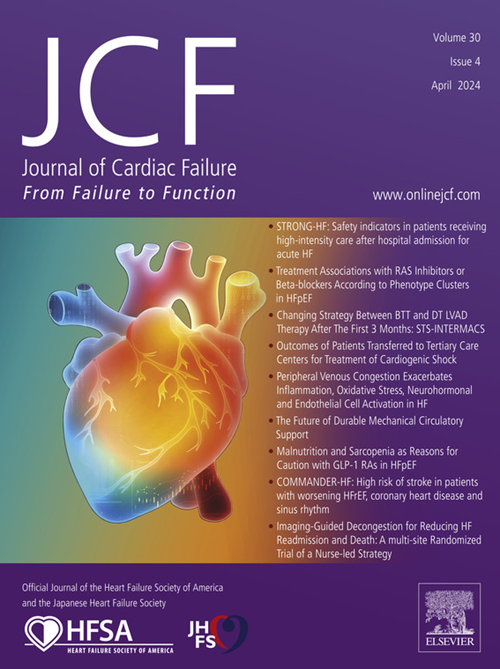Rationale and Design of the DECONGEST (Diuretic Treatment in Acute Heart Failure With Volume Overload Guided by Serial Spot Urine Sodium Assessment) Study
IF 6.7
2区 医学
Q1 CARDIAC & CARDIOVASCULAR SYSTEMS
引用次数: 0
Abstract
Aims
To evaluate whether early-combination diuretic therapy guided by serial post-diuretic urine sodium concentration (UNa+) assessments in acute heart failure (AHF) facilitates safe and effective decongestion.
Methods
The Diuretic Treatment in Acute Heart Failure with Volume Overload Guided by Serial Spot Urine Sodium Assessment (DECONGEST) study is a pragmatic, 2-center, randomized, parallel-arm, open-label study aiming to enroll 104 patients with AHF and clinically evident fluid overload requiring treatment with intravenous loop diuretics. Patients are randomized to receive standard of care or a bundled approach comprising: (1) systematic post-diuretic UNa+ assessments until successful decongestion, defined as no remaining clinical signs of fluid overload with a post-diuretic UNa+ ≤ 80 mmol/L; (2) thrice-daily intravenous loop diuretic bolus therapy, with dosing according to estimated glomerular filtration rate; (3) upfront use of intravenous acetazolamide (500 mg once daily [OD]); and (4) full nephron blockade with high-dose oral chlorthalidone (100 mg OD) and intravenous canreonate (200 mg OD) for diuretic resistance, defined as persisting signs of fluid overload with a post-diuretic UNa+ ≤ 80 mmol/L. The primary endpoint of the DECONGEST study is a hierarchical composite of (1) survival at 30 days; (2) days alive and out of hospital or care facility up to 30 days; and (3) greater relative decrease in natriuretic peptide levels from baseline to day 30.
Conclusion
The DECONGEST study aims to determine whether an intensive diuretic regimen focused on early combination therapy, guided by serial post-diuretic UNa+ assessments, safely enhances decongestion, warranting further evaluation in a larger trial powered for clinical events.
DECONGEST(以连续点滴尿钠评估为指导的急性心力衰竭伴容量超负荷的利尿剂治疗)研究的原理和设计。
目的:评估急性心力衰竭(AHF)患者在连续利尿后尿钠浓度(UNa+)评估指导下进行早期联合利尿治疗是否有助于安全有效地解除充血:通过序列点滴尿钠评估指导急性心力衰竭容量超载患者的利尿剂治疗(DECONGEST)研究是一项务实、双中心、随机、平行臂、开放标签的研究,旨在招募104名急性心力衰竭和临床明显液体超载患者,这些患者需要接受静脉环形利尿剂治疗。患者将随机接受标准治疗或捆绑式治疗,捆绑式治疗包括(1) 系统性地评估利尿后的 UNa+,直到成功解除充血,即利尿后的 UNa+≤80mmol/L,且无剩余的体液超负荷临床症状;(2) 每日三次静脉注射襻利尿剂,剂量根据估计的肾小球滤过率确定;(3) 先期使用静脉注射乙酰唑胺(500 毫克 OD);以及 (4) 使用大剂量口服氯塞酮(100 毫克 OD)和静脉注射卡诺酸(200 毫克 OD)进行肾小球全面阻断,以治疗利尿剂抵抗,利尿剂抵抗的定义是持续的液体超负荷迹象,且利尿后 UNa+ ≤80 毫摩尔/升。DECONGEST 研究的主要终点是:(1)30 天存活率;(2)30 天内存活并离开医院或护理机构的天数;(3)从基线到第 30 天,钠尿肽水平的相对降幅更大:DECONGEST研究旨在确定在连续的利尿后UNa+评估的指导下,以早期联合治疗为重点的强化利尿方案是否能安全地增强去充血效果,值得在更大规模的临床事件试验中进行进一步评估。
本文章由计算机程序翻译,如有差异,请以英文原文为准。
求助全文
约1分钟内获得全文
求助全文
来源期刊

Journal of Cardiac Failure
医学-心血管系统
CiteScore
7.80
自引率
8.30%
发文量
653
审稿时长
21 days
期刊介绍:
Journal of Cardiac Failure publishes original, peer-reviewed communications of scientific excellence and review articles on clinical research, basic human studies, animal studies, and bench research with potential clinical applications to heart failure - pathogenesis, etiology, epidemiology, pathophysiological mechanisms, assessment, prevention, and treatment.
 求助内容:
求助内容: 应助结果提醒方式:
应助结果提醒方式:


